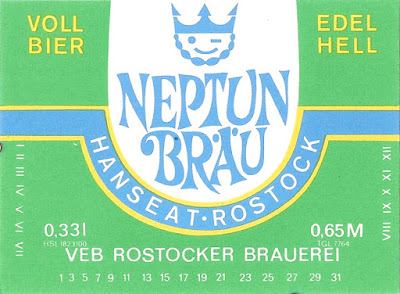It starts with the information which had to be on the label and continues with stuff which isn't allowed.
The following information must still be available:
Name and location of the manufacturing company and the addition: "Brauereiabzug." In the case of filling plants or publishers, the addition: "Verlegerabzug" or "Niederlageabzug".
Filling date in open or hidden form (day and month), goods number, according to TGL 7764.
It is not allowed:
additions like
Fassbier, Edel, Doppel, Spezial, Ur, alkoholarm, Echt, Eisbock, das Beste, das Edelste, das Feinste, aus bestem Malz und Hopfen bereitet and similar (with the exception of Doppel-Caramelmalzbier).
1960 TGL7764, page 8.
Most of the forbidden terms are just marketing bullshit.But one stands out as rather odd: Eisbock. Why on earth wasn't that allowed?
If you paid attention when looking at the lovely DDR labels I keep posting, you'll have spotted that the word Spezial appears quite often The rules seem to have changed. When we get to the 1980 version, you'll see that the section on forbidden terms has been removed.
Finally we get to packaging.
7 PACKAGING
For all types of bottling, the 0.33 liter (Steinie) bottles according to DIN 6199 issue 3.55 are to be used.
All other beer bottles may only be used until December 31, 1963.
White or semi-white bottles must not be used for pale beers.
Only hygienically perfect barrels, bottles and closures are to be used.
The keg filling for all types (except Jung- and Braunbier loose) in barrels with nominal contents of 1/8, 1/4, 1/3, 1/2 and 1/1 hl and larger.
A rinsing of the cleaned containers with catadynized water or SO2 gas as well as water containing SO2 is permitted, provided that traces are not detectable in the beer.
1960 TGL7764, page 8.
The Steinle bottle is the squat 33 cl bottle used for Duvel. This was by far the most common type of bottle used. Though Hell and Pilsner often came in half litre bottles.
Good to see that white glass wasn't allowed, at least for pale beers.
Not sure why there were different rules for Jungbier and Braunbier. Some of thiose barrel sizes are very small. 1/8 hl is just 12.5 litres.
Did I mention that I've found the TGL documents for malt and hops? They're up next. It's going to be a DDR summer.


Is it steinie or steinle?
ReplyDeleteGerman Wikipedia has this article
InSearchOfKnowledge,
ReplyDeleteit should be Steinie. OCR error.
I suppose there was no TGL definition for Eisbock so there was no reason for that term to be allowed. Even in West Germany hardly anyone made Eisbock.
ReplyDeleteHow much was an East German mark worth, compared to a West German one?
ReplyDeleteChris Pickles,
ReplyDeletethe official rate with the Deutschmark was 1 to 1. Unofficial, 6 or 7 to 1.